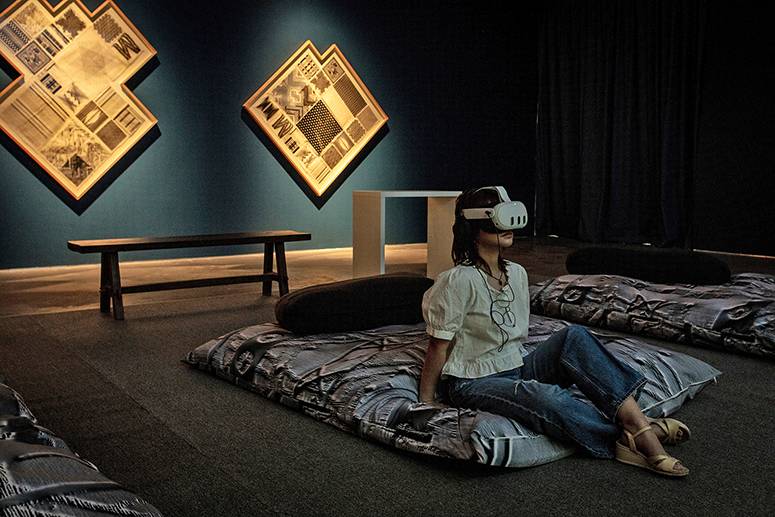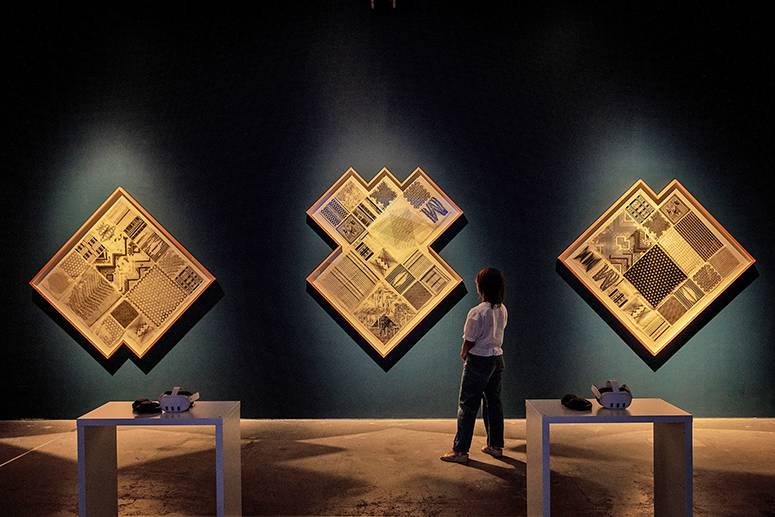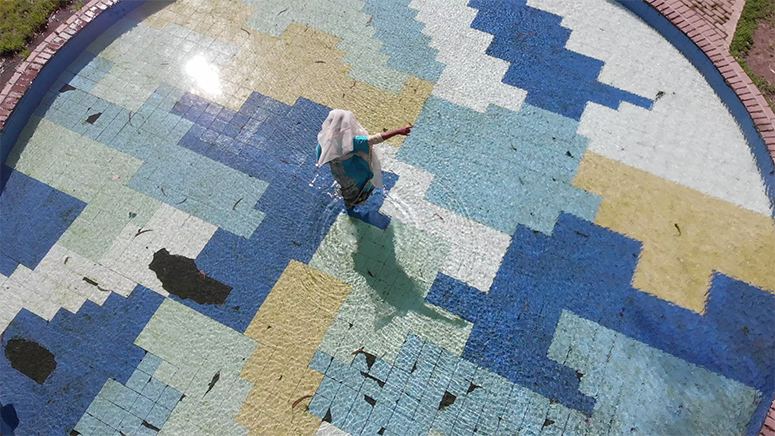Archivist of lives: The many i’s of ‘Piña’
A brown woman wearing a dress of radiant, regal blue sits in a kubo and tells us in English how she became a babaylan. Her sickness urged her to seek out a hilot, who then advised her to feed her ancestors and answer a calling to be a healer.
Janet Dolera, now a babaylan in Palawan, is the emotional, searching, and impressionable subject of a mystical initiation. Hers sounds like a tale that circulates as neighborhood gossip, and like many kinds of gossip, something is sorely amiss. In this condensed footage, the mystical is sovereign and yet its politics is inscrutable. Dolera’s abbreviated story is a weak foil to the stories of other women activists and indigenous leaders in Stephanie Comilang and Simon Speiser’s speculative documentary Piña, Why is the Sky Blue?
The exhibition, which opened last April 26 at Silverlens (Manila), locates one woman’s life, voice and thought beside another’s—an episodic narration bookended by a futuristic fable. How does documentary work become an open form? The question seems to throb at the pith of Piña.

Reacting to projects of anthropology, or many other representational genres that arrest the world in predictable ways, the Vietnamese-born filmmaker-polymath Trinh T. Minh-ha argues against speaking about or on behalf of another; she relishes the thought of speaking nearby. If a documentary is conventionally descriptive, Minh-ha pins her faith on poetic language. We may use the personal pronoun in poetry, but Minh-ha sees the “I” as a lush, open space for other voices to co-habit.
Some of this is happening in Comilang and Speiser’s work. The I’s shuttle and expand; lives refract onto each other. In Puyo Ecuador, the feminist activist-organizers called Cyber Amazonas form alliances among dispersed tribes and broadcast reports through radio and digital technologies. Shots of two women hunched over laptops play alongside lingering shots of immersing piña silk on a placid river. In Quito Ecuador, Alba Pavón, Afro-Ecuadorian botanical healer and leader of the Black Women’s Movement, narrates a life of displacement and dispute with an indigenous population. We are introduced to these stories as languages shift from English to Spanish to the indigenous Quechua.

The 28-minute documentary-style video holds their voices, alongside Dolera’s, nearby. Ecuador and the Philippines share histories of Spanish colonial rule. While the peeling away of contexts is sourly uneven, we gather slices of what survives through colonial sagas of erasure: Chants and crafts; healing rooted in the land and its lively spirits; and the belief that dreams foretell events in waking life. Everything a Quechua woman does is communication, says a CiberAmazonas activist. And indeed here, the woman is the medium. She guards and bears a wealth of ancestral knowledge. She occupies the worlds of dream and struggle, that fluid fertile place where magic is possible, and so is resistance.
It’s amusing that the project passes on these stories through the medium of video. The genre of documentary is itself a form of memory-keeping, of archiving knowledge—a genre both necessary and sometimes dangerously parasitic. Comilang and Speiser’s project, in turn, is critical of its own knowledge devices. It is skeptical of itself as both data and document. Distancing tactics crop up here and there: In a hut, children wear VR headsets; vertical clips slice through scenes like a TikTok reel.

The project’s chief device to signal its self-referential thrust is a futuristic plot in virtual reality. “Piña... we made another radio program and sent it to you,” goes a voice. “Piña, are we going to survive?” goes another. As it’s framed, the women are placed in a fictional storyline where they are not being interviewed by a documentarian but are instead addressing some unseen AI being. Observation becomes omniscience. It’s funny and deliciously absurd: A documentarian’s witnessing presence is dislodged by the eponymous tropical, colonial fruit, the all-knowing pineapple.
On the walls of the exhibition are framed piña cloths on which patterns are printed—some drawn from Filipino and Ecuadorian weaving traditions; others AI-generated. On the tables are VR headsets. Wearing them, we enter a hyperreal space where Piña gains true sentience in the form of a stunning androgynous queer figure speaking in the Visayan language. This is the future, we are told. Piña is replaying the data sent by the women we just watched.

Has the world collapsed? We find our bearings in this tropical paradise of ruins: in fraying, pixelated libraries; in a kubo, surrounded by trees; in deserted playgrounds; and in hotel rooms listening to Xanadu. In many scenes, Piña appears so unsettlingly near. It is Piña’s knowing stare—they look at us directly, lingeringly—that creates a potent relay of address: women addressing Piña, who turned human, addressing us.
While Piña is the ultimate archivist of lives, they are also the imaginative device that foils the documentarian’s urge to capture. The project, through the pineapple, makes an arduous leap into world-making.
But as sharply as it points its critical spear towards itself as document and data, the project still shies away from criticizing the forces that strain this side of the earth. I’m drawn back to Palawan and Dolera, still puzzling over why—for all its buoyant complexity—the project chose a tale so benign. Even in the footage as short as Pavón’s, we grasp the tense political weather of Ecuador: the spatial and racial dynamics, the violence of Black enslavement and forced migration, and the volatility of claiming land rights against the locals. By contrast, Dolera’s story—framed along the lines of spiritual destiny and service—seems stripped of social friction. The Philippines is an archive of aggression against land, activists, and spirits. How to speculate on a future when something in the present is not thrown into relief?
* * *
Piña, Why is the Sky Blue? runs until May 25 at Silverlens Manila.


